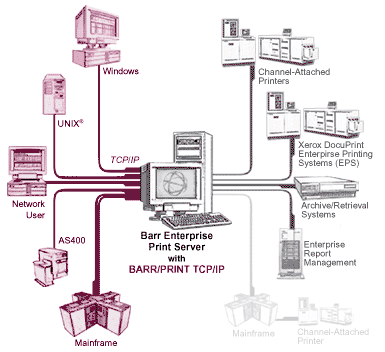
BARR/PRINT TCP/IP is a software module of the Barr Enterprise Print Server that allows you to receive data from any TCP/IP-based host (mainframes, UNIX An operating system for workstations developed by AT&T Bell Laboratories that features multiprogramming in a multiuser environment. computers, AS/400s, and so on) with LPD/LPR or with direct socket connections.

The Barr Enterprise Print Server with BARR/PRINT TCP/IP appears as a remote 4.3 BSD Acronym for Berkeley Software Development. printer to the UNIX host. It implements the LPD Acronym for Line Printer Daemon. The remote printer server that allows other hosts to print on a printer local to your host. to service LPRs Acronym for Line Printer Remote. The UNIX print command. This does not actually print files but rather copies them to a spool area from where a daemon copies them to the printer. from BSD 4.3 and System V hosts, or any type of system that provides LPR emulation. BARR/PRINT TCP/IP also provides a direct socket connection, which might be more appropriate depending on your needs.
If you are unsure if your host has been configured to provide LPR emulation, consult your system administrator, the command reference manual, or the online manual pages for more information.
BARR/PRINT TCP/IP includes the following features.
Routes print (using BARR/SPOOL) to parallel, serial, network, and S/390 channel-attached printers (using BARR/PRINT390)
Receives files from multiple hosts such as IBM mainframes, UNIX machines, AS/400s, and Windows Servers and clients
Supports unspecified file lengths
Receives data in ASCII (PCL Acronym for Printer Control Language. Hewlett-Packard uses this language in its LaserJet, DeskJet, and RuggedWriter printer lines. and PostScript), Barr S/370 channel, binary, or VBM Acronym for Variable Blocked with Machine carriage control. This is a standard mainframe file format. (for Xerox Metacode A Xerox-generated data stream that provides all-points addressability on Xerox centralized printers.)
Supports file transfers across a TCP/IP socket
Automatically routes a single job to multiple locations without duplication
Supports an unlimited number of LPD queues and the maximum number of socket ports allowed on the computer
Receives data from any TCP/IP-based host, including mainframes equipped with packages such as IBM's IP Printway and Levi Ray and Shoup's VPS/LCDS
Supports line print queue (LPQ) and line print remove (LPRM)
Uses RFC variables in the TCP/IP control file, including LPD queue name, job name, and user name, as criteria to route the job to any final destination
Handles multiple data files with one control file
Supports multiple control files in a single transmission
Handles and preserves all control file information
Customizes banner with control file information
Supports RFC1179